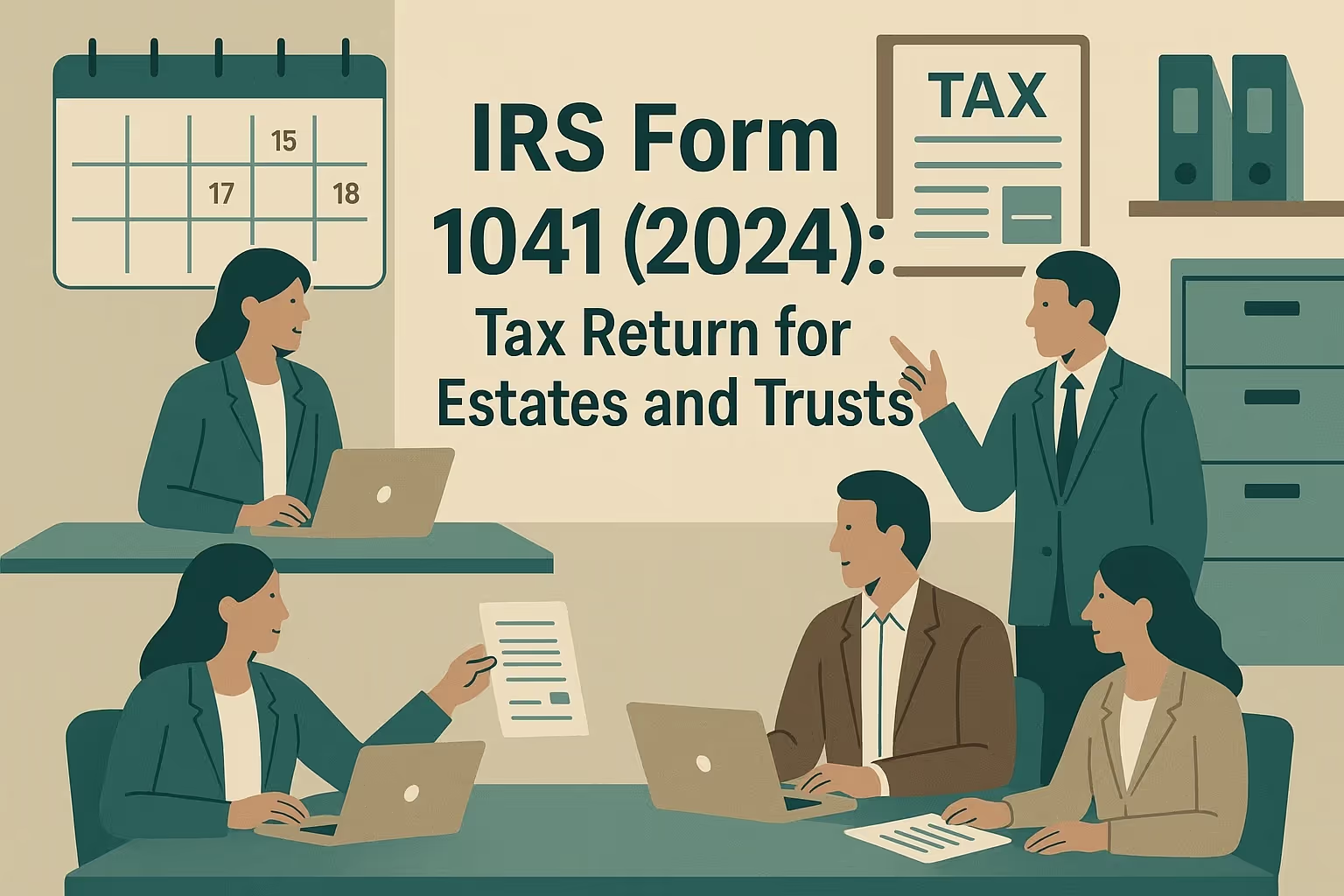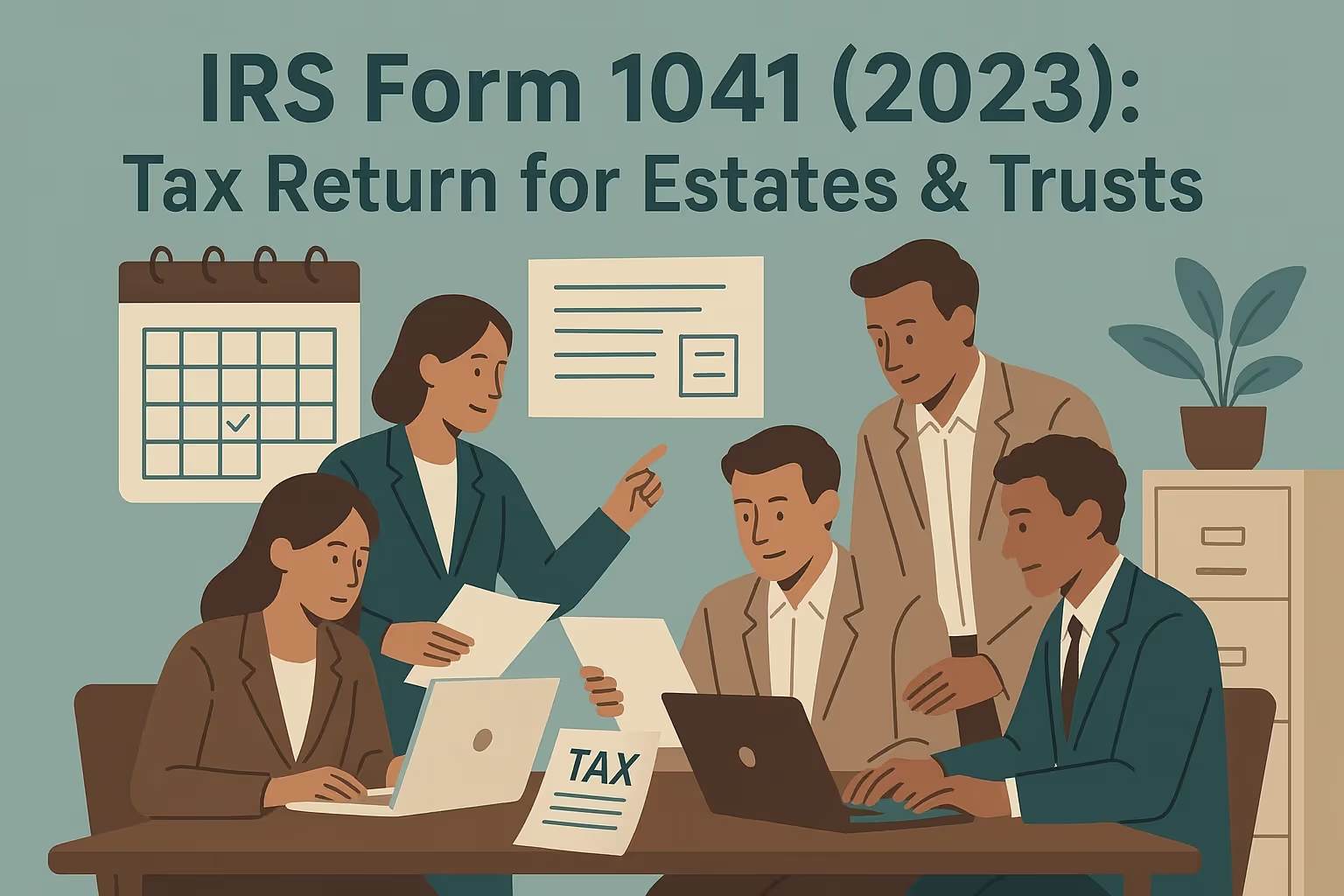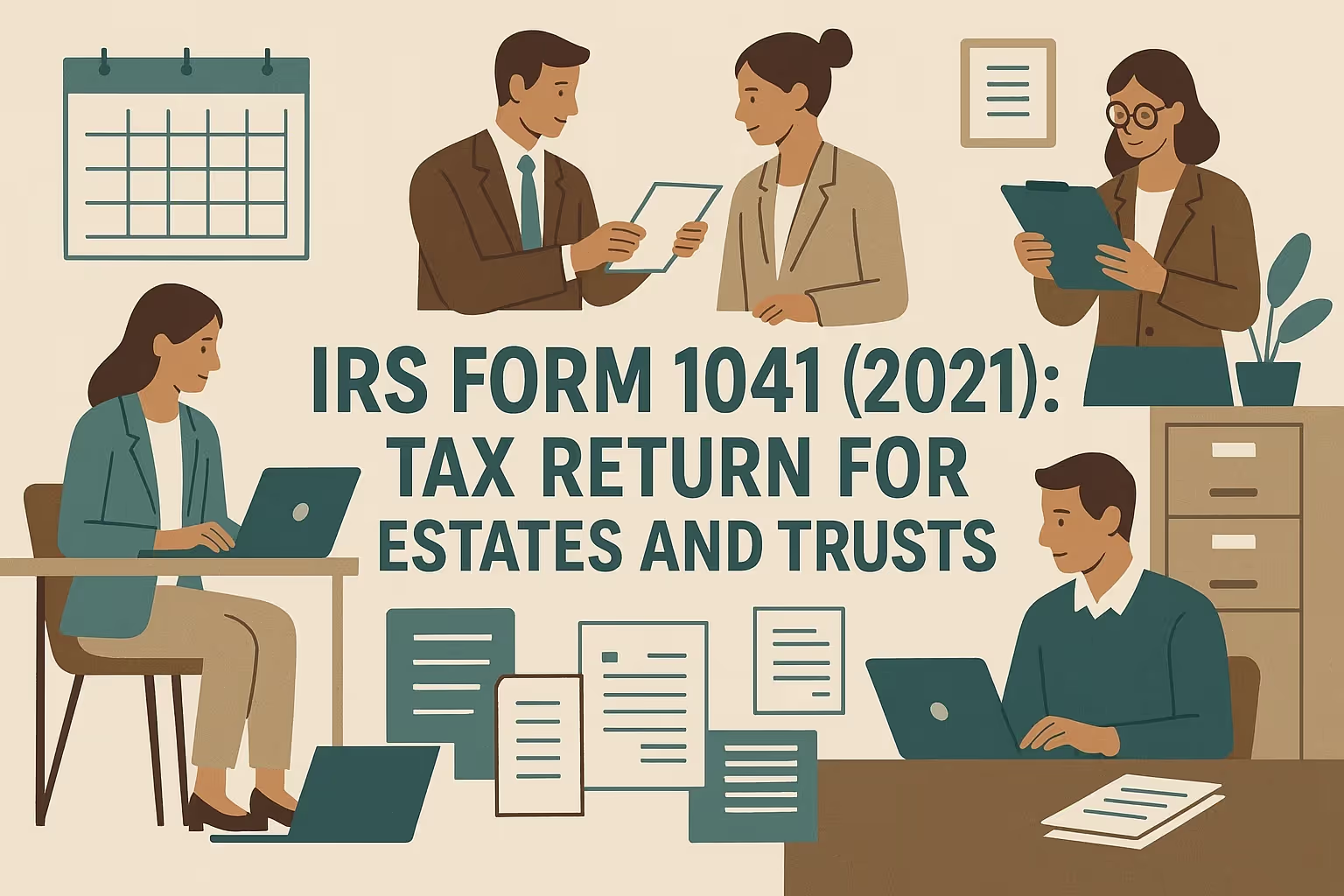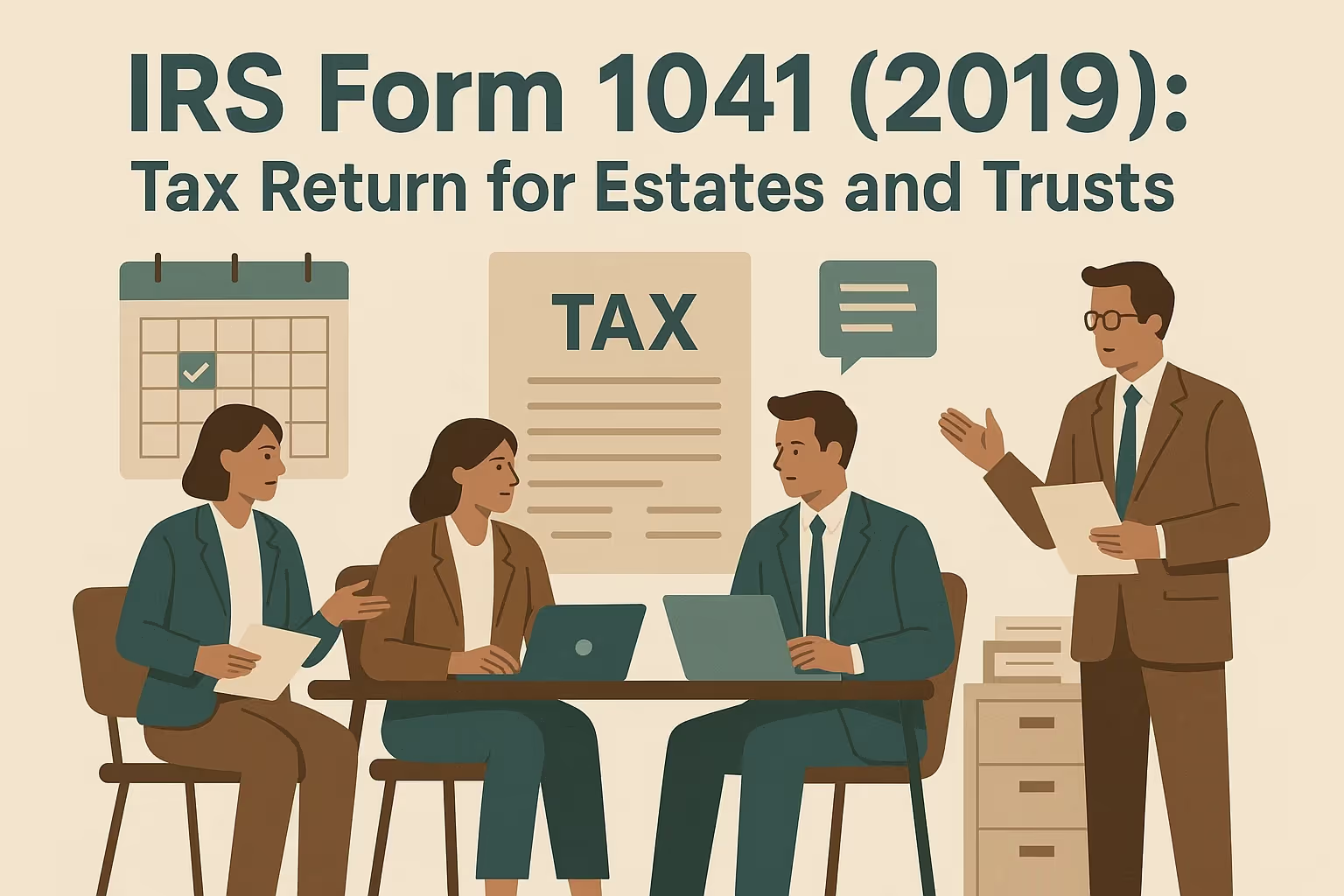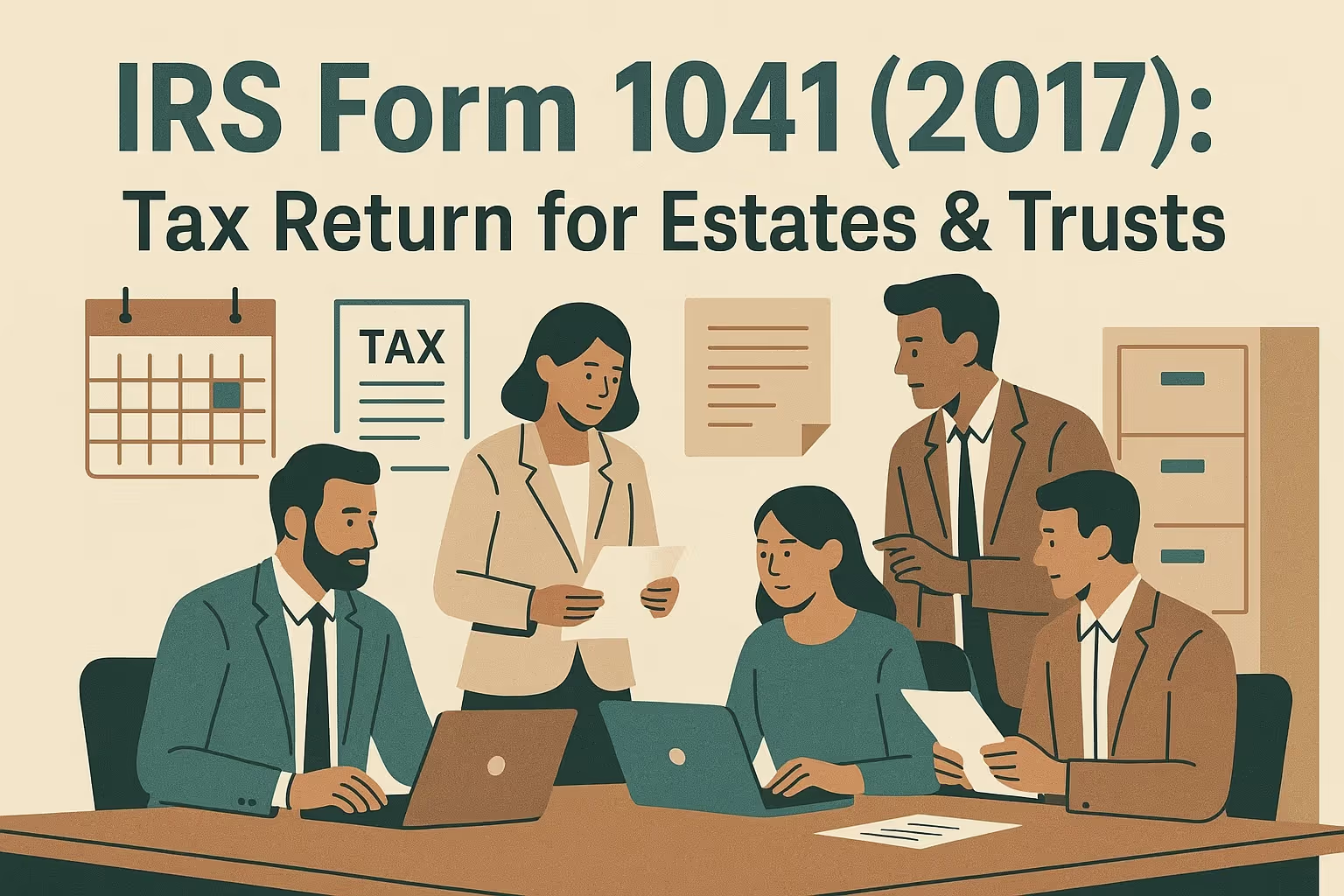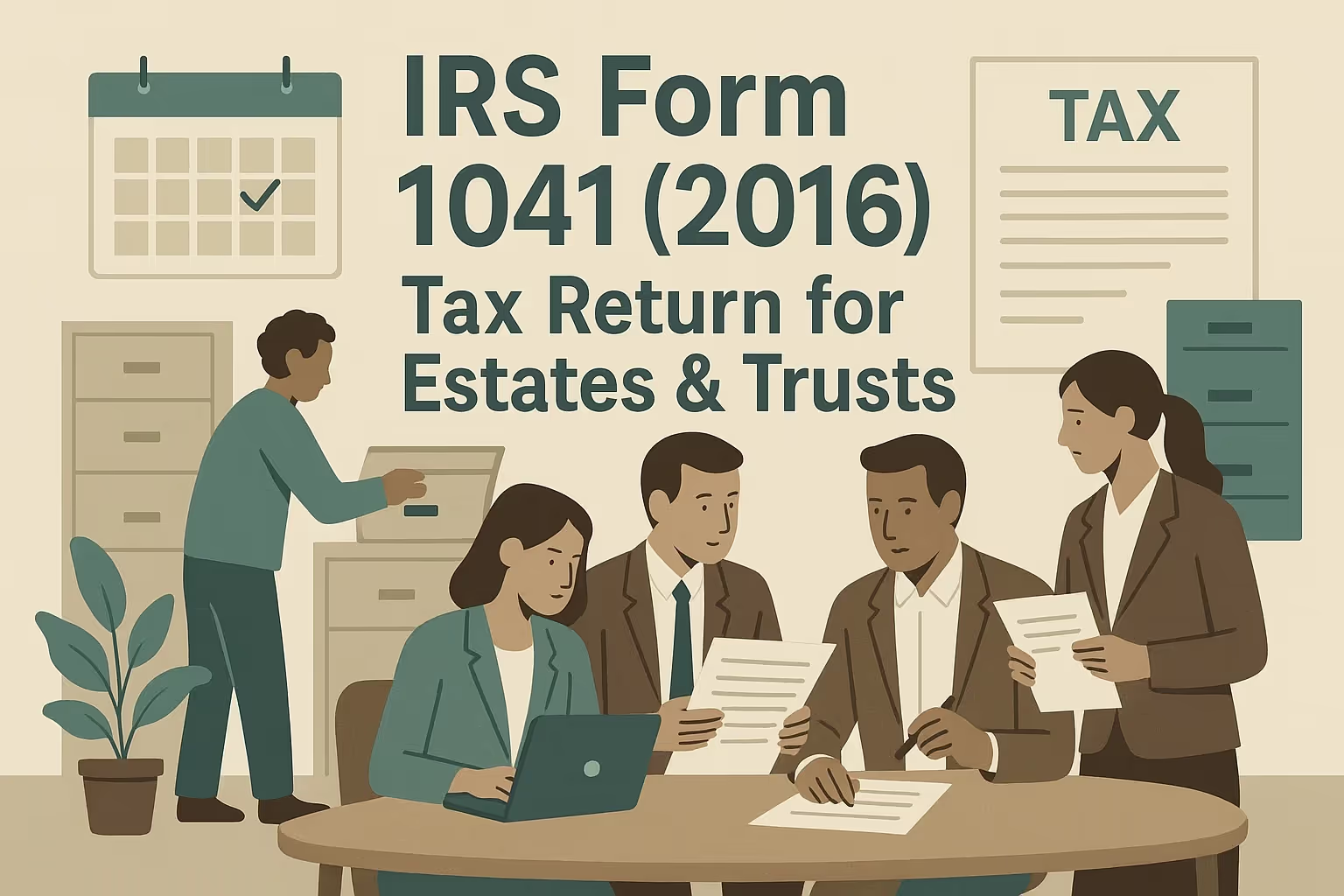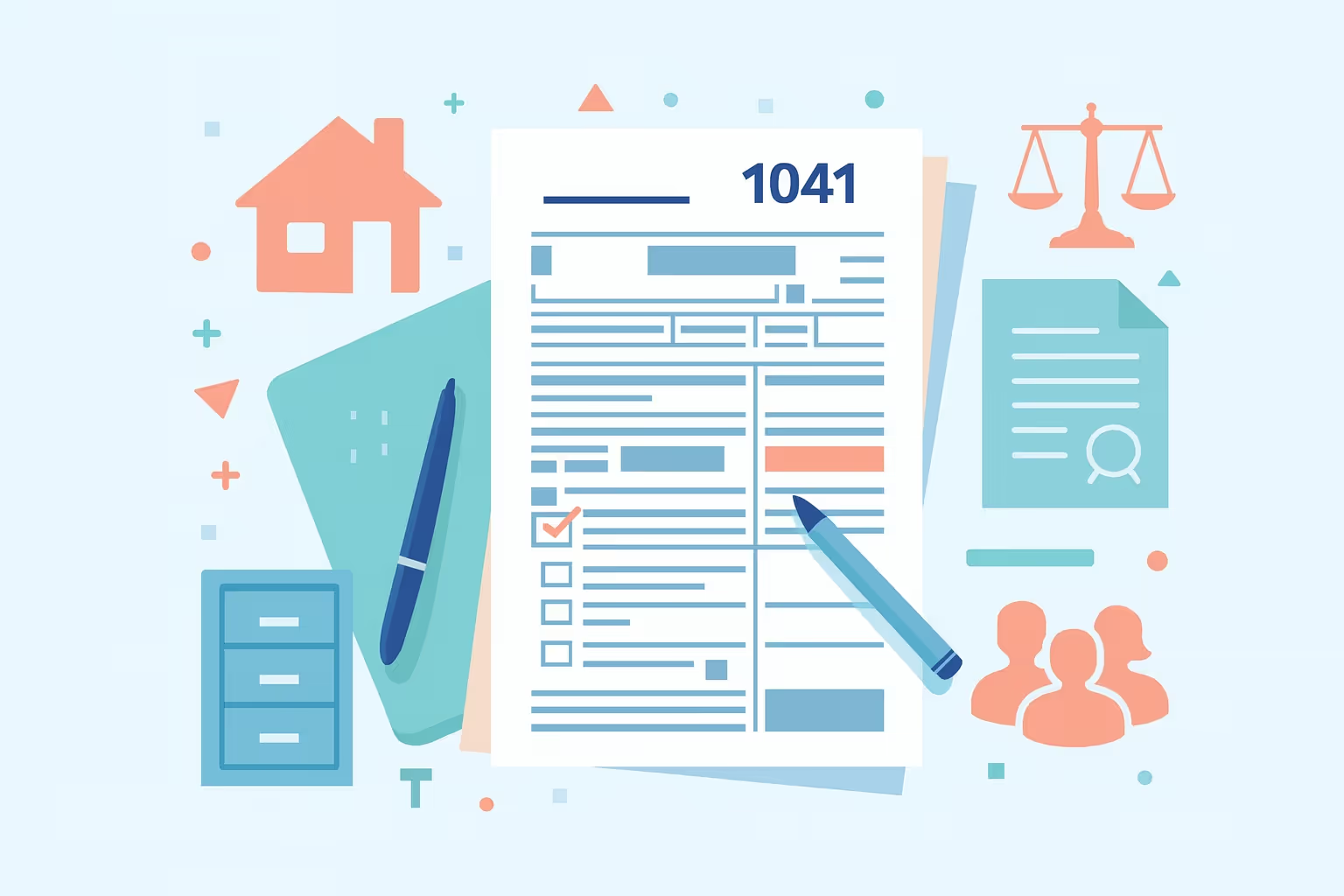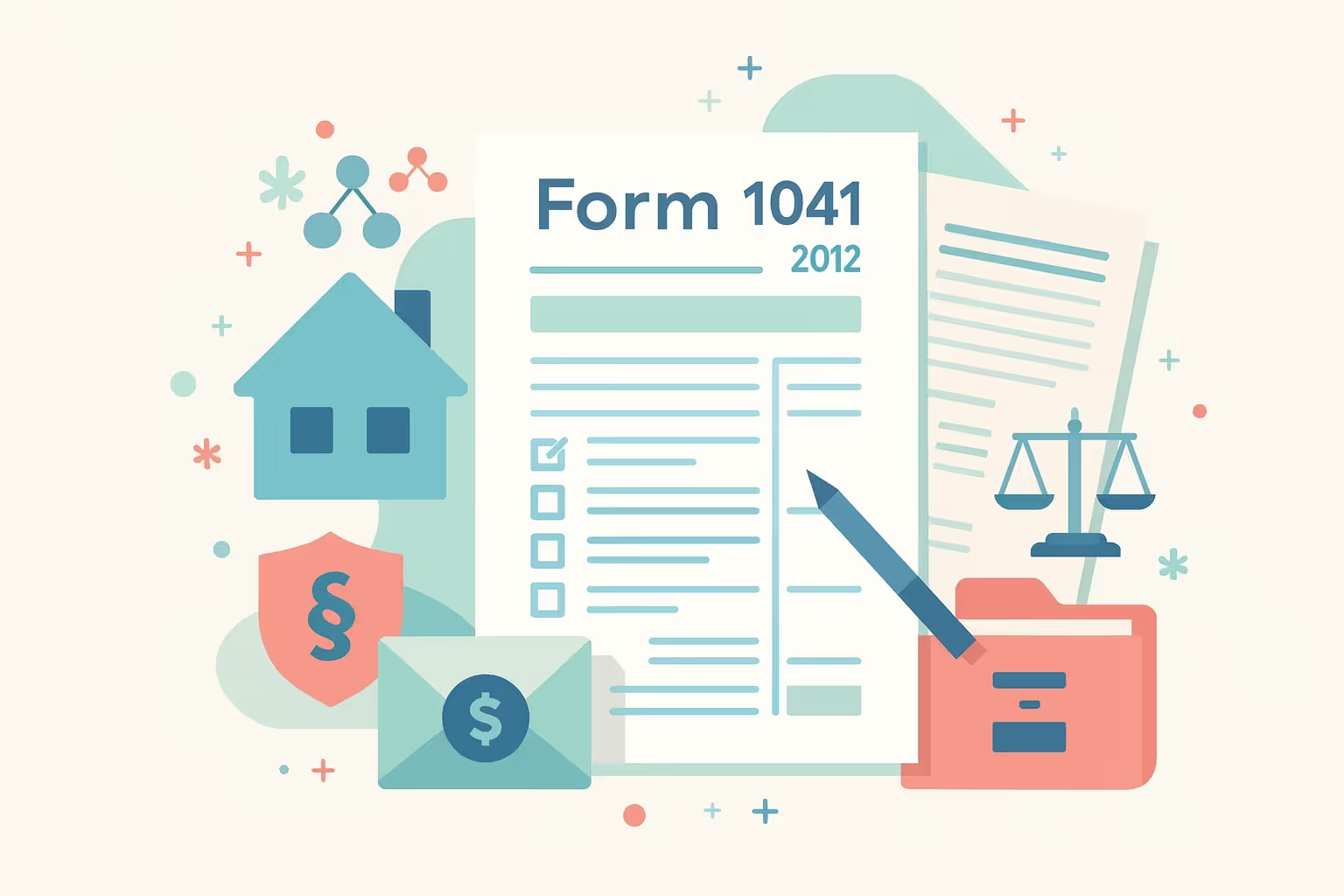IRS Form 1041 (2015): Tax Return for Estates & Trusts
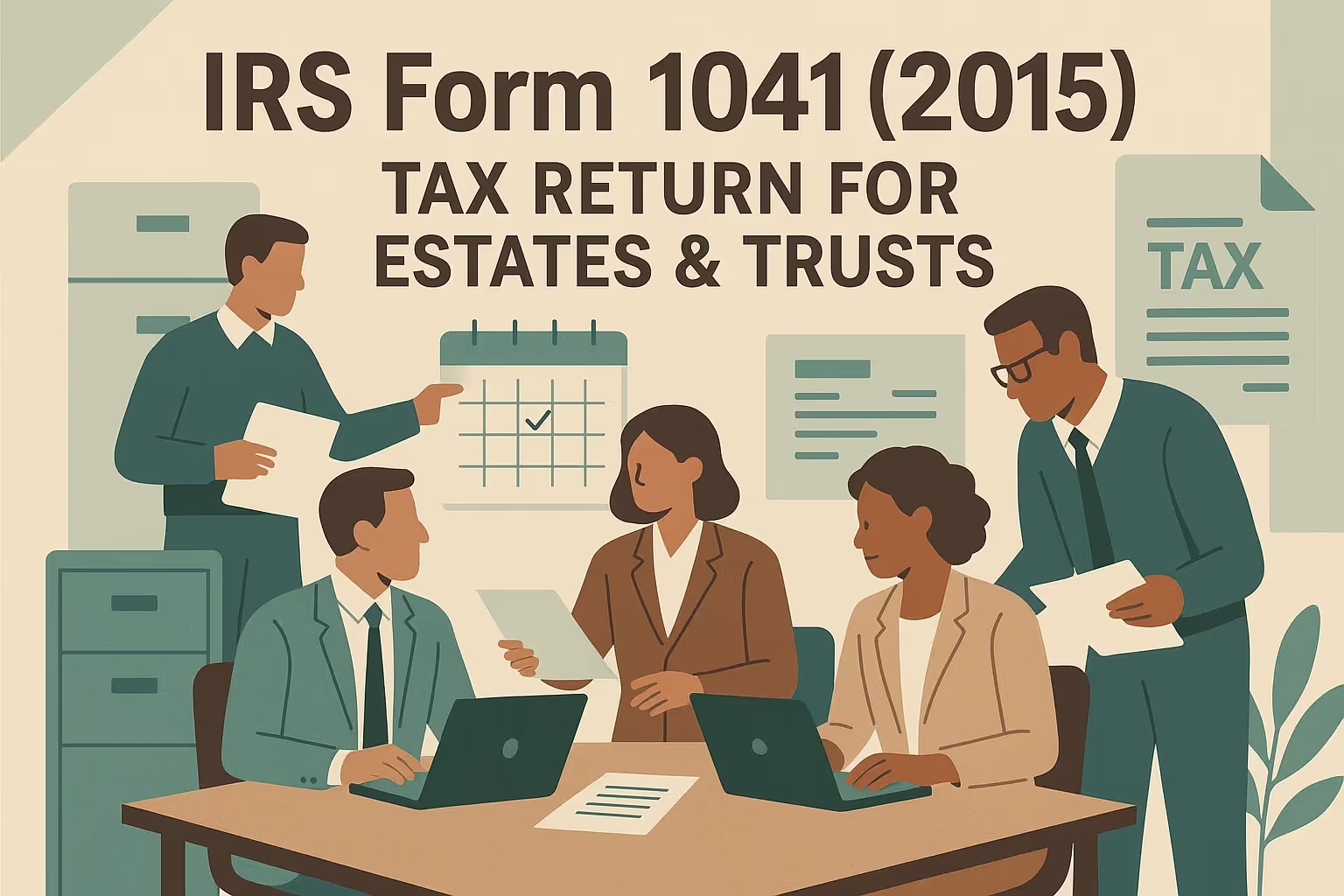
What IRS Form 1041 (2015) Is For
IRS Form 1041 (2015) is the income tax return that fiduciaries such as trustees, executors, or administrators must file for domestic estates and trusts. This income tax form is required by the Internal Revenue Service to report income, deductions, credits, and taxable income for the tax year. It also calculates the amount of income distributed to beneficiaries and the amount that remains with the estate or trust.
The fiduciary is responsible for filing the form, using the estate’s or trust’s Employer Identification Number, and ensuring that all financial activity—such as wages, capital gains, depreciation, and deductible expenses—is accurately reported. The form covers total income, property sales, interest, and other income sources from capital assets. It determines the income distribution deduction and any accumulation distribution that affects each beneficiary’s share.
If the IRS has already issued notices about your 2015 filing, our overview of the IRS collection process explains what to expect and how to respond at each stage.
When You’d Use Form 1041 for 2015 (Late or Amended Filing)
You might file a late or amended Form 1041 for 2015 if you discovered an unfiled return, received a notice from the IRS, or found additional income that was not reported. Common reasons include estates that earned rental or investment income, or trusts with gross income exceeding $600 during the tax year. Refunds are generally limited by law to three years from the original due date, which restricts refund opportunities for tax filings made in 2015 and earlier years.
If the estate or trust owes tax, you can pay by check, money order, or electronic transfer. Late filers are subject to penalties and interest, so it is advisable to prepare and complete the return promptly. Those using professional tax services may decide to e-file, which helps ensure faster confirmation and processing by the IRS. If you are dealing with a late fiduciary return or multiple unfiled years, you can review our guide on how to address unfiled federal returns to understand the next steps for compliance.
Key Rules Specific to 2015
- Original Due Date: The filing deadline for the 2015 Form 1041 was April 18, 2016 (April 19 for Maine and Massachusetts) due to the Emancipation Day holiday.
- Capital Gains and Dividends: The maximum rate was 20% on gains above $12,300, with 0% on income up to $2,500 and 15% from $2,500 to $12,300.
- Qualified Disability Trusts: Each qualified disability trust is eligible for a $4,000 exemption.
- Bankruptcy Estate Threshold: Estates with gross income of $10,300 or more were required to file.
- New Reporting Requirements: Basis reporting for estates and beneficiaries became mandatory and was delayed to February 29, 2016. Fiduciaries were required to provide disclosures to beneficiaries regarding transferred property and account details.
Those who need help understanding older or specialized tax forms can also use our IRS Form Help Center, which organizes many estate, trust, and fiduciary forms in one place.
Step-by-Step (High Level)
- Gather records: Collect IRS wage and income transcripts, investment records, and bank statements. Include any depreciation schedules, K-1 forms for beneficiaries, and proof of estimated tax payments.
- Use correct-year forms: You should download the official 2015 Form 1041 and instructions from IRS.gov. Always verify that the form displays the correct tax year and includes the locked padlock icon, which appears on the IRS page, to confirm authenticity.
- Attach schedules: You should include Schedule B, Schedule D for capital gains, and Schedule K-1s showing each beneficiary’s share of income, deductions, and credits.
- File and pay: You should mail your completed return to the address listed in the 2015 instructions or e-file using authorized software. Include Form 1041-V if paying by check or money order. If you are requesting an extension, please submit Form 7004 before the due date.
- Keep records: You should retain copies of filed returns, supporting schedules, and payment proof for a minimum of three years. These records help verify transactions if the IRS issues a notice or requests additional details.
Common Mistakes and How to Avoid Them
- Mixing fiduciary and beneficiary reporting: You should ensure income is not duplicated between the trust’s return and each beneficiary’s return.
- Missing K-1 deadlines: You should send Schedule K-1s to beneficiaries on time to avoid the $260-per-form penalty.
- Incorrect accounting periods: Confirm whether the estate uses a calendar year or a fiscal year, as trusts typically use a calendar year.
- Overlooking estimated tax payments: You should verify that all payments made during the year are correctly credited to the estate’s or trust’s account.
- Incorrect entity type: You should identify whether the entity is a simple trust, complex trust, grantor trust, or estate before filing.
- Failure to review deductions: You should carefully review deductible expenses to ensure that depreciation, taxes, and fees have been adequately deducted.
If penalties have already been assessed, fiduciaries may qualify for relief options. Our guide to IRS penalty abatement explains first-time relief rules and how reasonable cause applies to older-year filings.
What Happens After You File
The Internal Revenue Service generally processes 2015 Form 1041 income tax returns within 12 to 16 weeks, or faster if you e-file and pay electronically. If the estate or trust owes tax, interest, and penalties, they will continue to accrue until the account is paid in full, although payment plans using Form 9465 or online options are available.
Fiduciaries should carefully review the completed return, schedules, and payments to ensure that all income, deductions, and credits are reported accurately for the tax year. If the estate or trust cannot pay the full balance owed, you can review how IRS payment plans work to determine whether an installment agreement is available for fiduciary accounts.
FAQs
What’s the penalty for filing my 2015 Form 1041 late?
The IRS penalty is generally 5% of the unpaid tax per month, up to a maximum of 25% per year. If filed more than 60 days late, a minimum penalty of $135 applies. Interest also accrues from the original due date, so filing as soon as possible reduces additional charges.
Can I still receive a refund for my 2015 tax return?
Refunds for the 2015 tax year are generally limited to payments made within three years of the original due date. Most refund opportunities expired on April 18, 2019. Filing now only serves to meet reporting requirements or resolve IRS notices.
Do I also need to amend my state returns?
If you amend federal Form 1041 and it changes taxable income, deductions, or beneficiary distributions, you likely need to amend your state return. Each state has different deadlines and forms, so refer to your state’s tax agency for instructions.
What if I discover errors after I have filed?
You should file an amended Form 1041 using the 2015 version marked “Amended Return.” Attach a statement explaining each change, including corrected schedules and revised K-1s. Beneficiaries must also amend their own returns to match the updated figures.
How do fiscal year estates handle late filing?
Estates may elect a fiscal year rather than a calendar year. The due date is the 15th day of the fourth month after the year-end date. The same penalties and interest rules apply. Always review the applicable law before deciding how to prepare the return.
Can I set up a payment plan for the taxes I owe?
Yes, if an estate or trust cannot pay in full, it may request an installment agreement using Form 9465 or apply online at IRS.gov. Payment plans enable the balance to be paid over time, reducing the risk of enforcement actions.
What records should I keep after filing?
Fiduciaries should keep copies of the filed return, supporting schedules, beneficiary K-1s, payment receipts, correspondence, and any disclosures sent to the IRS. Maintaining organized records helps resolve future inquiries and supports the fiduciary’s authority under tax law.

















